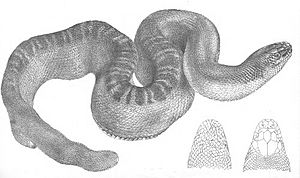Stokes's sea snake facts for kids
Quick facts for kids Stokes's sea snake |
|
|---|---|
 |
|
| from John Lort Stokes' 1846 Discoveries in Australia | |
| Conservation status | |
| Scientific classification | |
| Genus: |
Hydrophis
|
| Species: |
stokesii
|
| Synonyms | |
The Stokes's sea snake (Hydrophis stokesii) is a very large type of sea snake. It belongs to the family called Elapidae. Sometimes, scientists place it in its own special group, Astrotia. This snake lives only in the warm waters of the Indo-Pacific Ocean.
Contents
What's in a Name?
The snake's scientific name, stokesii, and its common name, Stokes' seasnake, are both a tribute to a brave naval officer. They are named after Royal Navy Admiral John Lort Stokes.
Appearance and Features
Stokes's sea snake is one of the heaviest and strongest sea snakes. It also has the longest fangs of any marine snake. Its fangs are long enough to go through a wetsuit.
This snake has a special keel on its belly. A keel is like a ridge or a bump. This keel is made from its enlarged belly scales. Sometimes, this keel looks like two small, bumpy warts.
Stokes's sea snake can have many different colors. It might be cream, brown, or even black. Often, it has wide black stripes or rings across its back. It can grow to be about 5 feet long.
Where It Lives
This sea snake can be found in many places. It lives in the waters near Pakistan and Sri Lanka. You can also find it in the South China Sea and the Strait of Taiwan. It also lives all around tropical Australia.
Interactions with Humans
Stokes's sea snake can be quite aggressive. It has a venomous bite. However, there are no known cases of this snake causing human deaths.
Sometimes, these snakes get caught by accident. This happens when fishing boats are trying to catch other sea creatures. For example, they can be caught in nets used for catching prawns in Australia.
Habits and Reproduction
Stokes's sea snakes sometimes travel together in huge groups. Thousands of them can drift along in long lines in the Strait of Malacca.
These snakes give birth to live young. They are called ovoviviparous. This means the eggs hatch inside the mother's body. Then, she gives birth to live baby snakes. They usually have small groups of about five young ones each time they reproduce.
About Its Scientific Name
The Stokes's sea snake was first described in 1846. It was named Hydrus stokesii by John Edward Gray. This happened in a book called Discoveries in Australia by John Lort Stokes.
Hydrophis stokesii at the TIGR Reptile Database


